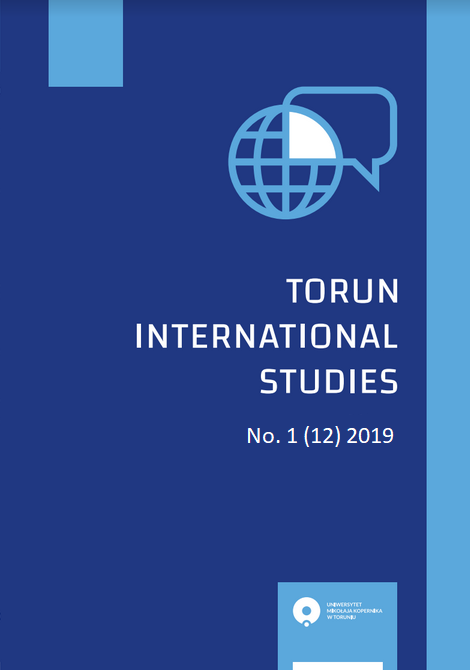FROM COUNTERBALANCING TO ENGAGING CHINA: SHIFT IN JAPAN’S APPROACH TOWARDS THE NEW INTERNATIONAL ORDER IN THE ASIA-PACIFIC UNDER THE SECOND ABE ADMINISTRATION
DOI:
https://doi.org/10.12775/TIS.2019.009Keywords
Japan, China, Asia-Pacific, Abe Shinzō, Japan–US alliance, Belt and Road InitiativeAbstract
Since returning to the post of prime minister in 2012, Abe Shinzō has been promoting Japan’s active posture in maintaining international stability in the Asia-Pacific. Abe’s vision of the new international order in the region has been based on Tokyo’s alliance with Washington, both in the security and economic spheres. Through legalization of Japan’s participation in collective self-defense pacts and revision of the Guidelines for Japan–US Defense Cooperation in 2015, Abe strengthened the Japan–US alliance. In parallel, he promoted Japan’s participation in the Trans-Pacific Partnership (TPP), which however was realized as Comprehensive and Progressive Agreement for Trans-Pacific Partnership without the Trump administration’s participation. In addition, Tokyo has been negotiating Regional Comprehensive Economic Partnership (RCEP), Japan–China–Republic of Korea Trilateral Free Trade Agreement, and Free Trade Area of the Asia-Pacific. The article argues that while initially the Japanese prime minister’s regional initiatives were aimed at counterbalancing China’s rise, they gradually started putting more emphasis on engaging China in international cooperation. Applying a neoclassical-realist methodology, this study examines both the international and the domestic determinants of Japan’s shift in approach towards the new international order.References
Abe, S. (2006). Utsukushii Kuni e [Towards a Beautiful Country]. Tokyo: Bungei Shunjū.
Abe, S. (2012, December 27). Asia’s Democratic Security Diamond. Project Syndicate. Retrieved December 25, 2018, from https://www.project-syndicate.org/commentary/a-strategic-alliance-for-japan-and-india-by-shinzo-abe?barrier=accesspaylog
Cabinet Secretariat (2014, July 1). Cabinet Decision on Development of Seamless Security Legislation to Ensure Japan’s Survival and Protect its People. Retrieved August 7, 2017, from http://www.cas.go.jp/jp/gaiyou/jimu/pdf/anpohosei_eng.pdf
Clinton, H. (2011, October 11). America’s Pacific Century. Foreign Policy. Retrieved August 13, 2017, from http://foreignpolicy.com/2011/10/11/americas-pacific-century/
Ito, A. (2019). China’s Belt and Road Initiative and Japan’s Response: From Non-participation to Conditional Engagement. East Asia, 36, 115–128. doi: https://doi.org/10.1007/s12140-019-09311-z
Kanehara, N. (2011). Senryaku Gaikō Genron [A Grand Strategy of Japan for the 21 Century]. Tokyo: Nihon Keizai Shinbun Shuppansha.
Ministry of Defense of Japan. (2015, April 27). The Guidelines for Japan-U.S. Defense Cooperation. Retrieved August 11, 2017, from http://www.mod.go.jp/e/d_act/anpo/shishin_20150427e.html
Ministry of Foreign Affairs of Japan. (2013, January 18). The Bounty of the Open Seas: Five New Principles for Japanese Diplomacy. Jakarta. Retrieved December 25, 2018, from http://www.mofa.go.jp/announce/pm/abe/abe_0118e.html
Ministry of Foreign Affairs of Japan. (2014a). Diplomatic Bluebook 2014. Retrieved November 4, 2019, from https://www.mofa.go.jp/policy/other/bluebook/2014/html/index.html
Ministry of Foreign Affairs of Japan. (2014b, April 6). The Three Principles on Transfer of Defense Equipment and Technology. Retrieved December 6, 2019, from http://www.mofa.go.jp/fp/nsp/page1we_000083.html
Ministry of Foreign Affairs of Japan. (2015, February 10). Cabinet Decision on the Development Cooperation Charter. Retrieved December 6, 2019, from http://www.mofa.go.jp/files/000067701.pdf
Ministry of Foreign Affairs of Japan. (2018a, May 9). Premier of the State Council of China Li Keqiang Visits Japan. Japan-China Summit Meeting and Banquet. Retrieved January 24, 2019, from https://www.mofa.go.jp/a_o/c_m1/cn/page3e_000857.html
Ministry of Foreign Affairs of Japan. (May 9, 2018b). Joint Declaration of the Seventh Japan-China-ROK Trilateral Summit. Retrieved November 1, 2019, from https://www.mofa.go.jp/a_o/rp/page4e_000817.html
Ministry of Foreign Affairs of Japan. (2018c, October 26). Prime Minister Abe Visits China. Retrieved November 4, 2019, from https://www.mofa.go.jp/a_o/c_m1/cn/page3e_000958.html
Ministry of Foreign Affairs of Japan. (2019a, April 12). Fifteenth Round of Negotiations on a Free Trade Agreement among Japan, China and the Republic of Korea. Retrieved November 1, 2019, from https://www.mofa.go.jp/press/release/press4e_002425.html
Ministry of Foreign Affairs of Japan. (2019b). Diplomatic Bluebook 2019. Retrieved November 4, 2019, from https://www.mofa.go.jp/policy/other/bluebook/2019/html/chapter1/c0101.html
Ministry of Foreign Affairs of Japan. (2019c, October 5). Free Trade Agreement (FTA) and Economic Partnership Agreement (EPA). Retrieved October 22, 2019, from https://www.mofa.go.jp/policy/economy/fta/index.html
Miyamoto, Y. (2019). Nitchū no Shippai no Honshitsu. Shin Jidai no Chūgoku to no Tsukiaikata [Essence of Sino-Japanese Failure. Method for Getting Along with China in New Era]. Tokyo: Chūō Kōron Shinsha.
Mori, I. (2019). Kantei Kanryō. Abe Ikkyō o Sasaeta Sokkin Seiji no Tsumi [The Residence’s Bureaucracy. The Sin of Aides’ Politics that Supported Abe’s Unilateral Strength]. Tokyo: Bungei Shunjū.
Nye, J.S. (1976). Independence and Interdependence. Foreign Policy, 22(Spring), 130-161. doi: https://doi.org/10.2307/1148075
Nukaga, F. (2010). Seiji wa Gēmu Dewanai. Senryakuteki Nihon Kaihō Keikaku [Politics Are Not a Game. Plan of Strategic Opening of Japan]. Tokyo: Sankei Shinbun Shuppan.
Rose, G. (1998). Neoclassical Realism and Theories of Foreign Policy. World Politics, 51(1), 144-172. doi: https://doi.org/10.1017/S0043887100007814
SIPRI. (2019). Military Expenditure by Country, in Millions of US$ at Current Prices and Exchange Rates, 1949-2018. retrieved November 4, 2019, from https://www.sipri.org/sites/default/files/SIPRI-Milex-data-1949-2018_0.xlsx
Stevenson, A. & Rich, M. (2017, November 11). Trans-Pacific Trade Partners Are Moving On, Without the U.S. The New York Times. Retrieved January 22, 2018, from https://www.nytimes.com/2017/11/11/business/trump-tpp-trade.html
Taniguchi, T. (2018). Abe Shinzō no Shinjitsu [Truth About Abe Shinzō]. Tokyo: Gokū Shuppan.
The World Bank. (2019). GDP (current US$) – China, Japan. Retrieved November 4, 2019, from https://data.worldbank.org/indicator/NY.GDP.MKTP.CD?locations=CN-JP
Waltz, K.N. (1990). Realist Thought and Neorealist Theory. Journal of International Affairs, 44(1), 21-37.
Wendt, A. (1999). Social Theory of International Politics. Cambridge: Cambridge University Press.
Yabunaka, M. (2010). Kokka no Meiun [Fate of the State]. Tokyo: Shinchōsha.
Yabunaka, M (2017). Turanpu Jidai no Nichibei Shin Rūru [New Japan–US Rules of the Trump Era]. Tokyo: PHP Kenkyūjo.
Yachi, S. & Takahashi, M. (2009). Gaikō no Senryaku to Kokorozashi. Zen Gaimu Jimujikan Yachi Shōtarō wa Kataru [Strategy and Ambition in Diplomacy. Narrated by Former Foreign Administrative Vice Minister Yachi Shōtarō]. Tokyo: Sankei Shinbun Shuppan.
Żakowski, K. (2019). Revision of Japan’s Foreign Policy After Donald Trump’s Electoral Victory. International Studies. Interdisciplinary Political and Cultural Journal, 23(1), 85-101. doi: http://dx.doi.org/10.18778/1641-4233.23.06
Downloads
Published
How to Cite
Issue
Section
Stats
Number of views and downloads: 725
Number of citations: 0



